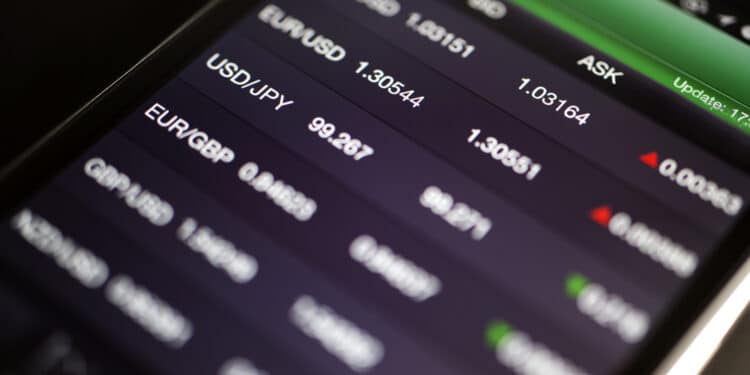A pip, or a percentage in point in full, is the smallest change in the price of a currency pair. Pips are the building blocks of all forex trades as they can help determine the position of take profit levels and stop losses. Further, any spreads charged on trade are calculated in pips. Pips are also vital to position sizing calculations and are at the forefront of risk management.
What is a pip?
As aforementioned, a pip is the smallest change in the price of a currency pair. Now, most pairs’ prices are quoted to four decimal places, except pairs involving the Japanese yen. Therefore, for the majority of pairs, a pip is any change in the fourth decimal place onwards. This means that one pip would be equivalent to a 0.0001 change in the pair’s price.
For pairs involving the JPY, their prices tend to be quoted to two decimal places. This means that for these pairs, a pip is equivalent to a 0.01 change in price in either direction. Sometimes, brokers will quote these prices up to three decimal places. In such a situation, a change in the third decimal place, or a 0.001 change, constitutes a tenth of a pip, usually called a pipette. This means that for pairs not involving the JPY, a pipette would be equivalent to a 0.00001 change in price.
How pips work
For this, let’s consider an example. Let’s assume we’re trading the GBPUSD pair. First, in this pair, the British pound is the base currency while the US dollar is the quote currency. If the pair is quoted at 1.3700, this means that it costs 1.3700 dollars to purchase one British pound.
Now, assume we bought the pair at 1.3700. A few hours later, its price climbed to 1.3705, at which point we chose to exit our trade. Now, our profit can be calculated by the difference between the selling price and our buying price, in pips. Therefore, our profit amounted to 5 pips. Usually, most brokerage platforms will calculate your profits and losses in pips for you, but it is vital to know how these calculations work.
The monetary value of a pip is dependent on the lot size of our trade. The lot size refers to the number of currency units we purchased or sold in a trade. The standard lot size comprises 100,000 units. Since this may be too large a number for most traders, most brokers also offer mini lots of 10,000 units, micro-lots of 1,000 units, and nano lots of 100 currency units.
Calculating a pip’s monetary value
From our example, we purchased 100,000 GBP at $1.3700 each. This means that it cost us $137,000 to buy 100,000 GBP. The pair’s price then went up 5 pips to $1.3705, after which we sold our holdings. The monetary value of each pip is calculated by dividing the decimal equivalent of a pip (0.0001) by the current exchange rate (1.3705). The result of this is then multiplied by the lot size of our trade. Thus, this boils down to:
(0.0001/1.3705) * 100,000 = 7.30 GBP.
Therefore, a pip movement is equivalent to 7.30 British pounds. This brings our total profit to 7.30 * 5 = 36.48 GBP. We can convert this to dollars using the current exchange rate to obtain: (36.48 * 1.3705) = $50.
Alternatively, we can calculate this profit by multiplying our lot size by the current exchange rate.
100,000 GBP * 1.3705 = $137,050.
Subtracting this from our buying price, we obtain our profit as:
$137,050 – $137,000 = $50.
Now, a $50 dollar profit from a $100,000 investment does not seem very lucrative. To increase your profit margin, you need to utilize leverage in your trades.
What is leverage?
When trading forex, you can use the leverage from your broker, which allows you to control much larger amounts than your investment. This way, even a slight change in pips can translate to significant profits. On the flip side, however, even the smallest pip change against your position could lead to huge losses.
All in all, leverage allows you the opportunity to get higher market exposure at much lower costs. The leverage a broker provides is dependent on the regulations of their jurisdiction. Some brokers offer leverages of 50:1, others 200:1, others even 500:1.
The leverage offered determines your margin requirement, i.e., the minimum investment you require to enter a trade. For example, a 500:1 leverage means you’ll need a ((1/500) * 100) = 0.2% margin. This means that you’ll need 0.2% of the total value of your position in your equity as a deposit to enter the trade.
Understanding spreads
When trading forex, you’ll notice that most brokers will quote two prices for each pair. The price on the left is their buying price, called the bid price. The price on the right is their selling price, or ask. The difference between the ask price and the bid in pips is the spread. This is the fee the broker charges for their services.
Spreads can be fixed or variable. Variable spreads change according to the volatility of the pair and other market conditions, such as the pair’s liquidity. To determine the actual cost of a broker’s spread, you need to calculate the monetary value of a pip. This is important as spreads can eat away your profits.
Conclusion
A pip is the smallest change in the price of a currency pair. In most pairs, a pip constitutes a change in the fourth decimal place of its price. In pairs involving the JPY, a pip is usually a change in the second decimal place of the quoted price. Pips are vital in calculating profits and losses, risk management, and calculating spreads charged by brokers. An understanding of pips is also vital in determining how much leverage is appropriate to take on.




